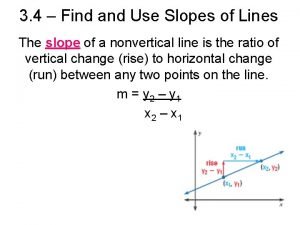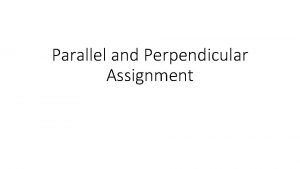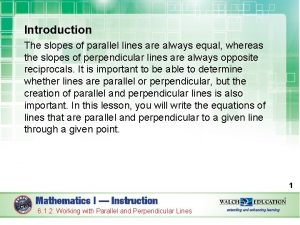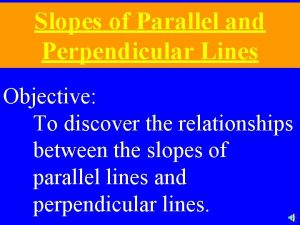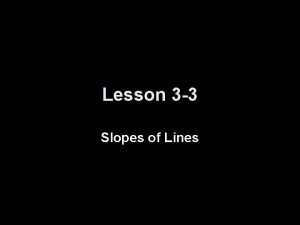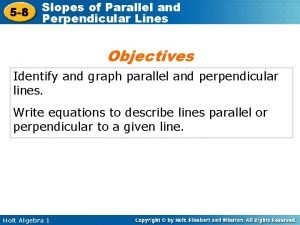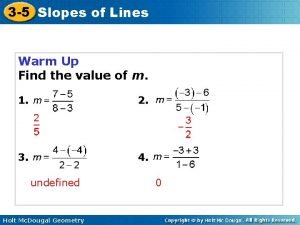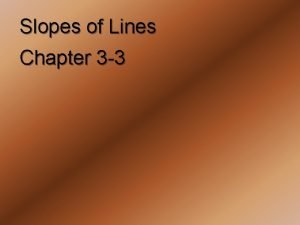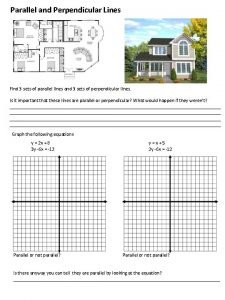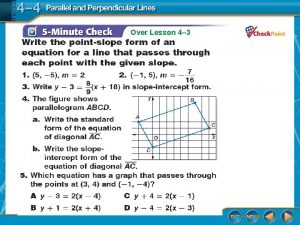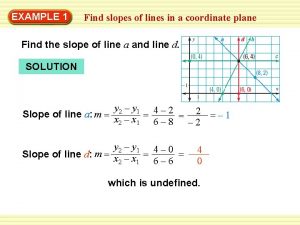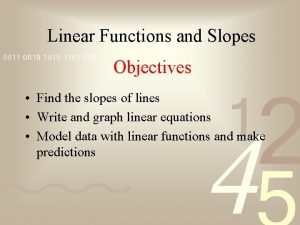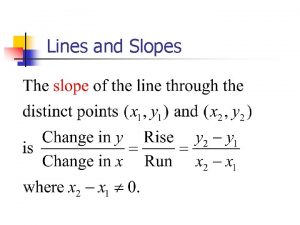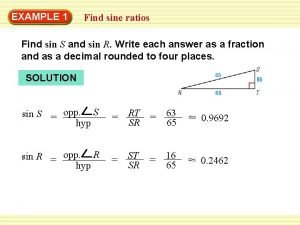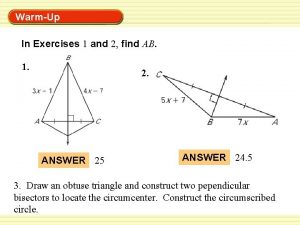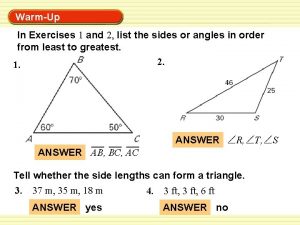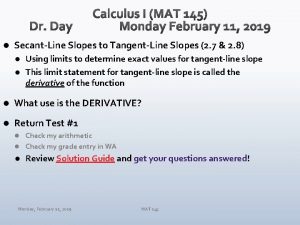WarmUp 1 Exercises EXAMPLE Find slopes of lines











- Slides: 11

Warm-Up 1 Exercises EXAMPLE Find slopes of lines in a coordinate plane Find the slope of line a and line d. SOLUTION y 2 – y 1 4 – 2 2 Slope of line a: m= = = x 2 – x 1 6 – 8 – 2 = – 1 y 2 – y 1 4 – 0 Slope of line d: m = x – x = = 2 1 6– 6 4 0 which is undefined.

Warm-Up Exercises GUIDED PRACTICE for Example 1 Use the graph in Example 1. Find the slope of the line. 1. Line b ANSWER 2

Warm-Up Exercises GUIDED PRACTICE for Example 1 Use the graph in Example 1. Find the slope of the line. 2. Line c ANSWER 0

Warm-Up 2 Exercises EXAMPLE Identify parallel lines Find the slope of each line. Which lines are parallel? SOLUTION Find the slope of k 1 through (– 2, 4) and (– 3, 0). m 1 = 0– 4 = –– 41 = 4 – 3 – (– 2 ) Find the slope of k 2 through (4, 5) and (1, 3). m 2 = 1 – 5 3– 4 = – 1 = 4

Warm-Up 2 Exercises EXAMPLE Identify parallel lines Find the slope of k 3 through (6, 3) and (5, – 2). m 3 = – 2 – 3 5– 6 – 5 = – 1 = 5 Compare the slopes. Because k 1 and k 2 have the same slope, they are parallel. The slope of k 3 is different, so k 3 is not parallel to the other lines.

Warm-Up Exercises GUIDED PRACTICE 3. for Example 2 Line m passes through (– 1, 3) and (4, 1). Line t passes through (– 2, – 1) and (3, – 3). Are the two lines parallel? Explain how you know. ANSWER Yes; they have the same slope.

Warm-Up 3 Exercises EXAMPLE Draw a perpendicular line Line h passes through (3, 0) and (7, 6). Graph the line perpendicular to h that passes through the point (2, 5). SOLUTION STEP 1 Find the slope m 1 of line h through (3, 0) and (7, 6). m 1 = 6 – 0 = 6 = 3 7– 3 4 2

Warm-Up 3 Exercises EXAMPLE Draw a perpendicular line STEP 2 Find the slope m 2 of a line perpendicular to h. Use the fact that the product of the slopes of two perpendicular lines is – 1. 3 2 m 2 = – 1 m 2 = – 2 3 STEP 3 Slopes of perpendicular lines Multiply each side by 2 3 Use the rise and run to graph the line.

Warm-Up 4 Exercises EXAMPLE Standardized Test Practice SOLUTION The rate at which the skydiver descended is represented by the slope of the segments. The segments that have the same slope are a and c. ANSWER The correct answer is D.

Warm-Up Exercises GUIDED PRACTICE 4. for Examples 3 and 4 Line n passes through (0, 2) and (6, 5). Line m passes through (2, 4) and (4, 0). Is n m? Explain. ANSWER Yes; the product of their slopes is – 1. 5. In Example 4, which parachute is in the air for the longest time? Explain. SAMPLE ANSWER Parachute C. It was in the air approximately 1. 25 minutes longer than either a or b.

Warm-Up Exercises GUIDED PRACTICE 6. for Examples 3 and 4 In Example 4, what do the xintercepts represent in the situation? How can you use this to eliminate one of the choices? SAMPLE ANSWER Time of the landing. b and c are in the air different amounts of time.
 Find and use slopes of lines
Find and use slopes of lines Vertical
Vertical Parallel perpendicular or neither
Parallel perpendicular or neither Slopes of parallel and perpendicular lines assignment
Slopes of parallel and perpendicular lines assignment Slopes of parallel lines are always
Slopes of parallel lines are always Two lines are parallel if their slopes are
Two lines are parallel if their slopes are 3-3 slopes of lines answer key
3-3 slopes of lines answer key 5/8 perpendicular
5/8 perpendicular 3-5 slopes of lines
3-5 slopes of lines 3-3 slopes of lines
3-3 slopes of lines 3 sets of parallel lines
3 sets of parallel lines Slopes of parallel and perpendicular lines lesson 8-1
Slopes of parallel and perpendicular lines lesson 8-1
